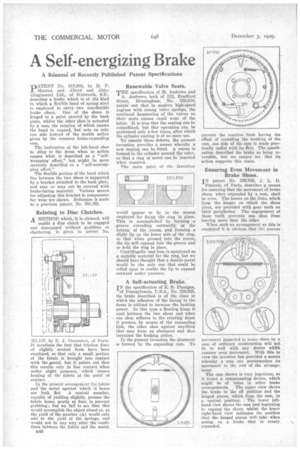A Self-energizing Brake
Page 74

If you've noticed an error in this article please click here to report it so we can fix it.
A Resume of Recently Published Patent Specifications PATENT No. 317,932, by H. P. Maxted, and Alford and Alder (Engineers) Ltd., of Walworth, S.E., describes a brake which is of the kind in which a flexible band of spring steel is employed to carry two non-flexible brake shoes. One of the shoes is hinged to a point carried by the back plate, whilst the other shoe is actuated by a cam, the rotation of which causes the band to expand, but acts on only one side instead of the double action given by the common brake-expanding cam.
The inclination of the left-hand shoe to cling to the drum when in action causes what is described as a "selfwrapping effect," but might be more correctly described as a 4' self-unwrapping effect."
The flexible portion of the band which lies between the two shoes is supported by a bracket attached to the back plate, and may or may not be covered with brake-facing material. Various means for adjusting this bracket to compensate for wear are shown. Reference is made to a previous patent, No. 301,261.
Relating to Disc Clutches.
A: METHOD which, it is claimed, will enable a disc clutch to be engaged and disengaged without grabbing or chattering, is given in patent No.
121,137, by E. J. Desroziers, of Paris. it mentions the fact that friction discs of slightly conical form have been employed, so that only a small portion of the fabric is brought into contact with the 'petal, but it points out that this results only in line contact when under slight pressure, which causes heating of the fabric at the point of contact. .
In the present ,arrangement the fabric and ' the metal against which it beam are both fiat. A conical member, capable of yielding slightly, presses the fabric home, gently at first, to prevent grabbing ; but we fail to see that this would accomplish the object aimed at, as the yield of the member (A) would only add te the yield of the springs, and would not in any way alter the condi-, tions between the fabric and the metal.
B48
Renewable Valve Seats.
THE specification of H. Andrews and
A. Andrews, both of 312, Bradford Street, Birmingham, No. 320,830, points out that in modern high-speed engines with strong valve springs, the continual hammering of the valves on their seats causes rapid wear of the latter. It is true that the seating can he remachined, but this operation Sean be performed only a few times, after which the cylinder casting is of no more use.
To remedy these defects, the present invention provides a means whereby a new seating can be fitted. A recess is formed in the cylinder around the valve, so that a ring of metal can be inserted when required.
The main point of the invention
would appear to lie in the means employed for fixing the ring in place. This is accomplished by forming ,a. groove extending outwardly at the bottom of the , recess, and. forming a slight lip on the lower side of the ring, so that when pressed into the recess, the lip will expand into the groove and so hold the ring in place.
Centrifugally cast iron is mentioned as a suitable material for the ring, but we should have thought that a ductile metal would be the only one that could be relied upon to enable the lip to expand outward under pressure.
A Self-actuating Brake.
IN the specification of E. B. Flanigan, of Pennsylvania, U.S.A., No. 319,925, the brake described is of the class in which the adhesion of the facing to the drum is utilized to increase the braking power. In this type a floating hinge is used between the two shoes and when one shoe adheres to the rotating drum it presses, by means of the connecting link, the other shoe against anything that may form an abutment and thus increases the braking action.
In the present invention the abutment is formed by the expanding cam. To
Ensuring Even Movement in Brake Shoes.
IN patent No. 320,709, J. L. D. Pimoule, of Paris, describes a means for ensuring that the movement of brake shoes, when expanded by a cam, shall be even. The bosses on the links, which form the hinges on which the shoes pivot, are provided with gear teeth on their peripheries. The engagement of these teeth prevents one shoe from moving more than the other.
When such an arrangement as this is employed it is obvious that the uneven
movement imparted to brase shoes by a cam of ordinary construction will not fit in well with any device wh.tch ensures even movement. With this in view the inventor has provided a means whereby a cam can accommodate its movement to the rest of the arrangement.
The cam shown is very ingenious, as it forms a compensating device, which might be of value in other brake arrangements. The upper view shows the brake in the off position and the hinged pieces, which form the cam, in
a central position. The lower lefthand view shows the cam just beginning to expand the shoes, whilst the lower right-hand view indicates the position that the hinged pieces will take when acting on a brake that is evenly expanded.




















































































































